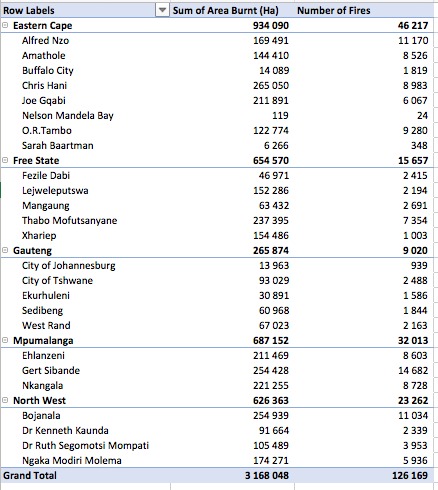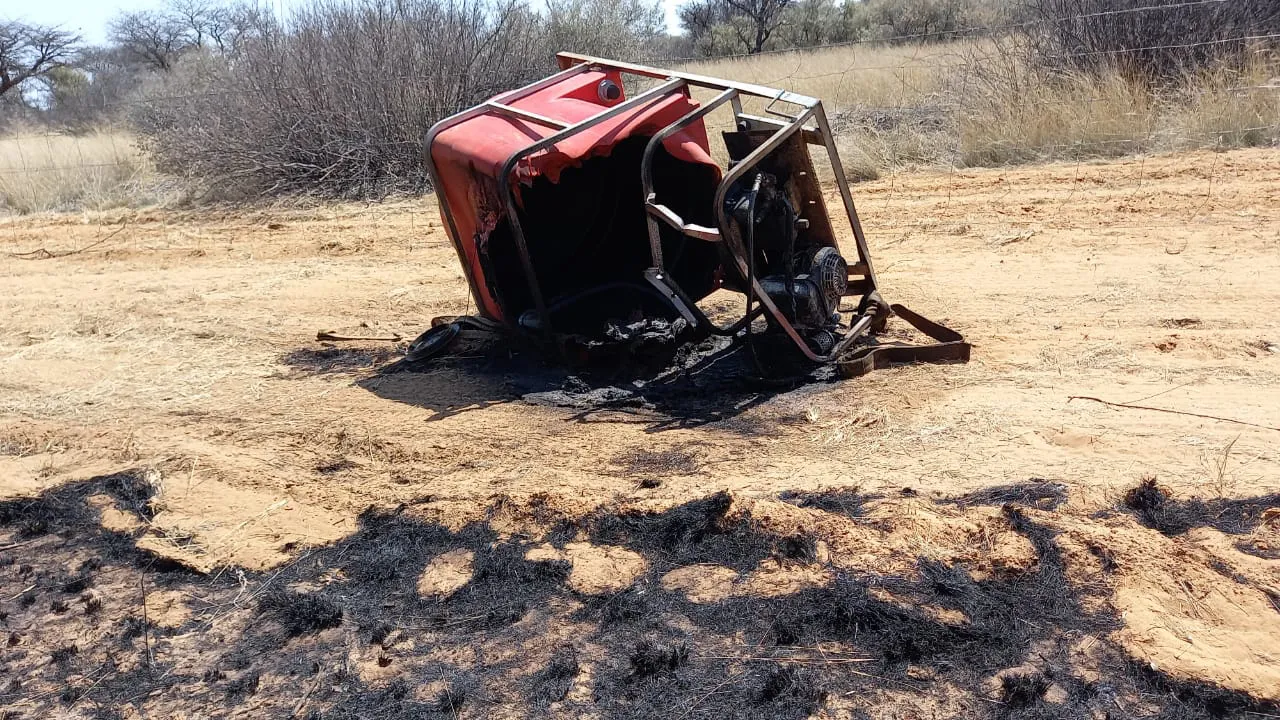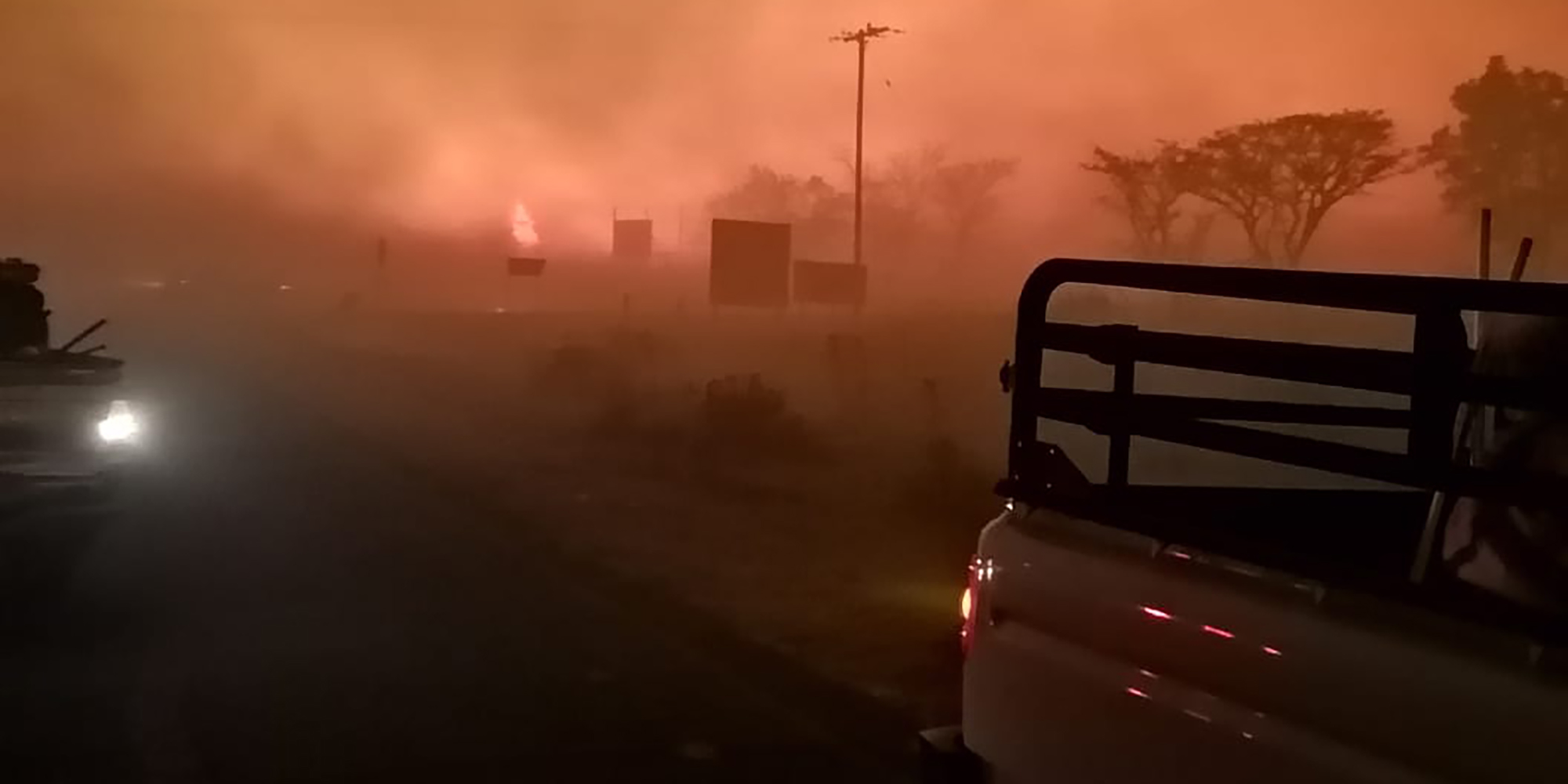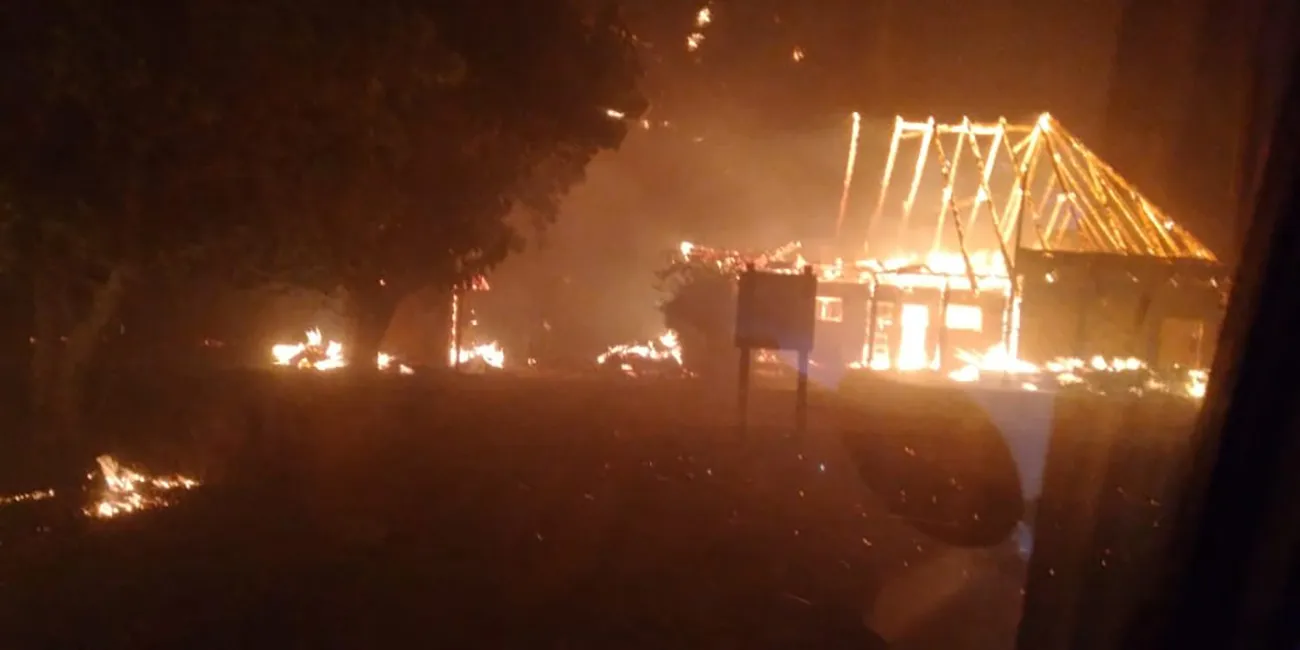OUR BURNING PLANET
The burning season: Wildfires sweeping across South Africa and Namibia have left devastation in their wake

More than two million hectares of grazing land were burnt in fires across South Africa over the past year. In neighbouring Namibia, more than half a million hectares were lost.
Veld fires have left two firefighters dead and destroyed more than two million hectares in the Free State, North West, Northern Cape and Eastern Cape this year. In neighbouring Namibia, 580,480ha was burnt.
The wildfires also destroyed infrastructure and killed livestock.
 The chairperson of the North West Umbrella Fire Protection Association, Eric Thabo Stoch, said two volunteer fighters died in separate fires in Vryburg and Ottosdal.
The chairperson of the North West Umbrella Fire Protection Association, Eric Thabo Stoch, said two volunteer fighters died in separate fires in Vryburg and Ottosdal.
“About 8,000ha and six houses were burnt, four people were hospitalised and countless animals died… some were injured from the fire on the south of the Magaliesberg mountain recently,” he said.
“Kumbagana Game Lodge is burnt out,” Stoch said.
He said 626,164ha have burnt in North West, with 23,991 burn scars reported from 1 May to 14 September 2021.

“It is estimated that the losses are now between R3-billion and R3.5-billion for the season. About 12% of agricultural land and 6% of the North West province has been destroyed by wildfires… 41.3% of the area burnt from 1 May to 31 August is in Bojanala,” he said.
Stoch said not only farmers suffered losses.

A burnt-out firefighting unit in North West. Veld fires injured four volunteers in the province. (Photo: Supplied)
Parts of the Magaliesberg Biosphere, an international reserve proclaimed by UNESCO in 2015 for its exceptional natural, cultural and human characteristics, were burnt by veld fires last month. The reserve also forms part of the Cradle of Humankind World Heritage site.
Stoch said losses at the heritage site could not be quantified, and that the hidden cost is the loss to the environment and its tourism potential.
“There are massive job losses, destruction of livelihoods, food security for subsistence and emerging farmers, tribal lands, destruction of the environment and infrastructure.
“There are also the costs of combating the fires. Most of the fires are being extinguished and fought by unpaid volunteers, going with their own teams at their own cost to save the lives of people they do not know in areas up to 200km from where they reside,” said Stoch.
He said the fires are due to a number of factors that include:
- Drought because farmers reduced stock levels and thus there is a lot of fuel/combustible material;
- Non-compliance of land owners and state entities with the Veld and Forest Fire Act of 1998;
- Arson;
- Negligence;
- Lack of firebreaks;
- People burning rubbish dumps;
- People making fires while waiting for taxis on the side of road and then leaving the fires burning;
- Discarded cigarette butts;
- Eskom lines not maintained and no firebreaks — in high winds the lines touch and spark, causing fires and;
- Political unrest.
The new Intergovernmental Panel on Climate Change report warns that extreme weather events are likely to be more frequent as a result of global warming.
The extreme weather events caused by the climate crisis are making the environment drier and scientists predict that there will be more heat waves and longer periods of drought as temperatures increase, making the environment more susceptible to wildfires
A number of countries have been hit by devastating wildfires in recent weeks, including Algeria, Italy, France, Turkey, America, Canada and Greece.

Motorists had to stop as veld fires spread in North West. (Photo: Supplied)
Free State fires
Elana Bester, communication officer for Free State Agriculture, said the Free State Umbrella Fire Protection Association report for July 2021 indicated that the province had lost 338,259ha to wildfires.
“We suspect that the latest fires could add another 60,000ha. Farmer Piet van Staden in the Dewetsdorp area lost 400 sheep with an approximate value of R1-million, while Jaco Burger from the Wepener area lost 1,000 of his 1,300ha,” she said.
The most damaging blaze was the Petrusburg fire on 13 July, when agricultural infrastructure was destroyed and 82,137ha of grazing land were burnt. Spreading at a rate of 3,851ha an hour, the fire took more than 27 hours to contain. A considerable number of livestock was injured and killed and numerous structures, including four residential buildings, were damaged.
Compared with the 2020 and 2019 veld fires, this year the Free State recorded 338,259ha burnt, while 62,204ha were burnt in 2020 and 23,771ha in 2019. More than 52 farms have been destroyed.
Andrea Campher, Agri SA’s risk and disaster manager, said it was estimated that more than 270,000ha were destroyed by fire in the Northern Cape.

Property burns in North West. Volunteers battled the blazes for more than five days. (Photo: Supplied)
“Agri SA, via its structures, is in the process of assessing the damage, but is concerned that the challenges on the ground are much greater than the information at our disposal,” said Campher.
She said dry and strong winds had created ideal conditions for runaway fires.
“The extent of the damage is such that, should the affected districts be declared disaster areas, the state would not have the capacity to assist farmers. Given bureaucratic red tape, it will be impossible to provide disaster relief in time, because state resources are under pressure as a result of the Covid-19 pandemic and drought aid that is currently being rolled out in terms of the prevailing drought disaster declaration,” Campher said.
She said the demand for roughage was already under pressure due to feed aid provided to drought-stricken areas.
“Agri SA is encouraging the public to contribute to the organisation’s disaster relief fund, which is managed by the Agri SA Disaster Relief Foundation. Donors also qualify for a section 18(A) certificate. Funds will be used specifically for the purchase of stock feed, transportation costs and infrastructure such as fencing to safeguard livestock,” Campher said.
Eastern Cape fires
Thinus Botha, CEO of the Eastern Cape Umbrella Fire Protection Association, said they had a similar season to previous years.
“We are slowly coming out of a prolonged drought situation, and this should mean more grass and therefore more fires. The vegetation is slow to respond to the better rainfall due to the length of the drought,” he said.
Botha said they had had a devastating fire in the Ugie area, damaging extensive areas of the plantation.
“This definitely made the season more devastating. We implemented a new burn scar tool to utilise satellite technology to detect and map these burn scars. This technology has been used this fire season for the first time due to cost implications. Therefore we only monitored the grassveld in the northern part of the Eastern Cape, thus excluding the Sarah Baartman district area,” he said.

North West farmers and volunteers fought veld fires that burnt Kumbagana and moved to Zuurplaat, burning structures and injuring volunteers. (Photo: Supplied)
Botha said they found astonishing results and would like to continue with the product, but that they needed to find funding.
“Since May this year, the system detected more than 36,000 burn scars with a total burnt area of more than 910,000ha. We had spring rain that started over some areas and are now hoping for follow-up rain that will assist in turning the seasons,” he said.
Dordrecht Fire Association member, Carl Miles, said there had been an increase in veld fires this year in their area compared with 2020.
“We only had one small fire last year and there was nothing major. This year alone we have had 14 big fires. Two of these fires were caused by human negligence,” he said.
Komani farmer Simon Sutton said they had more than 19 separate fires in their area over the winter season.
“Our area covers the Bonkolo Basin and the Hangklip Valley around Komani. Most, if not all, of these fires have been lit on purpose. We have had a huge problem this year with fires that started in the mountains of Zingquthu and Lesseyton,” he said.
Sutton said it is a tradition of the farmers in these areas to burn the mountain veld to regenerate growth and remove old veld.
“However, these fires are not controlled and often lit on windy days and they do not care if the fires burn their entire veld and enter the neighbouring farms. This practice is actually degrading to the veld as it damages the roots of the grass and removes tons of carbon from the soil,” said Sutton.
He said due to the better rainy season of 2020/21, most areas have more grass than previous years.
“This has also been one of the reasons why the fires have been more damaging this year and more difficult to kill and control. There is a need to educate farmers about the negative effects of uncontrolled burning and the damage it is causing to the environment as a whole,” he said.
Sutton said uncontrolled burning led to soil degradation which led to erosion and loss of valuable grazing for livestock.
KwaZulu-Natal fires
KwaZulu-Natal Fire Protection Association operations manager Simon Thomas said they had seen a decline in fires as a result of intermittent rains throughout the dry season.
In June this year, 1,110ha were burnt in KwaZulu-Natal, while 1,540ha were burnt in July and 1,759ha in August.
Namibia fires
Namibia’s Minister of Environment, Forestry and Tourism, Pohamba Shifeta, said the country had seen several devastating fires that threatened lives, property, the natural environment, crops, livestock and game across the country.
Shifeta said the most fire-prone regions were Kavango East, Kavango West, Otjozondjupa, Oshikoto, Zambezi, Ohangwena, Kunene, Oshana, Omusati, Khomas, Hardap and Omaheke.
“This year alone, a total of 580,480ha were burnt countrywide, from May to September.”
Shifeta said 99 forest/veld fires occurred in several regions: four in Omusati covering 11,554ha, nine in Khomas covering 75,000ha, five in Oshikoto covering 18,900ha, 16 in Zambezi covering 80,420ha, seven in Kunene covering 100,167ha, 12 in Kavango East covering 40,000ha, 11 in Kavango West covering 45,500ha, 11 in Omaheke covering 30,764ha, 16 in Otjozondjupa covering 85,891ha and eight in Hardap covering 20,284ha.
“In the Omusati region, 21 goats and sheep were burnt to death and two cattle posts were destroyed. In Khomas, 25 farms burnt and 491 livestock and game were killed… one human life was lost and four people were severely injured,” said Shifeta. DM/OBP
[hearken id=”daily-maverick/8738″]


















Fire is a complex (and emotive) subject. I think we will be making a mistake if we blame all of the increase in fires on Climate Change. CC has definitely played a part, but perhaps not as much as (1) the fact that we have drilled boreholes all over the place and sucked the water-table much lower than it used to be, leaving the vegetation on the surface in a drier state than it might otherwise have been (2) our changing Land Use management – fire has always been a part of Africa’s Ecology (there is even a bird – the Bronze-winged Courser – that has evolved charcoal coloured eggs and nestlings that look, for all the world, like little tufts of charred grass). However, we have now put buildings and other infrastructure in areas which are at risk from being burned regularly. (3) We have tended to avoid fire too much WITHOUT taking appropriate steps to compensate – perhaps by using dense herds of livestock to graze/trample the fuel load back to safe levels. There is going to be a webinar on Fires (in Australia) under their Climate Council on Thursday 7th October at 10am our (SA) time. Interested readers should search You Tube for Climate Council Firestorm anytime after Monday 11th if they are interested in following this topic further. Bruce Danckwerts CHOMA, Zambia